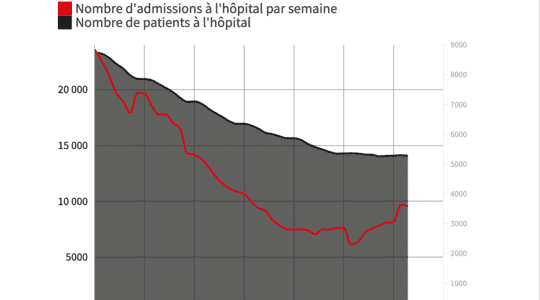Omicron has been the main variant of Covid-19 in France for several months. With it appeared the sub-variants (BA.1, BA.2, BA.3, BA.4 and BA.5) which are subject to special monitoring by the health authorities. If the BA.2 remains dominant compared to the others, it begins to be overtaken by the last two which are essential little by little in all the contaminations.
At the same time, the number of cases recorded daily in the territory is also increasing, despite disruptions in official records due to public holidays and weekends. The European Center for Disease Prevention and Control (ECDC) thus alerted, on Tuesday June 14, to the possibility of an increase in the number of daily cases in Europe in the coming weeks “carried” by these sub-variants.
Breakthrough of BA.4 and BA.5 sub-variants
With fewer barrier gestures and the end of almost all health restrictions (with the exception of the obligation to wear a mask in health-related establishments), BA.4, BA.5 are suspected of contributing to a rise contamination in several European countries, including France. They are rapidly gaining ground and should eventually supplant BA.2, dominant since the start of the year. It could be the same in the UK or Germany. Among the sub-variants identified, BA.3 never became established.
To view the infographic, Click here
In his last weekly update of June 9, Public Health France mentions an advance in the two sub-variants BA.4 and BA.5 and a decline in BA.2. While they were respectively at 0.8% for BA.4 and 5% for BA.5 in all the contaminations recorded in the June 2 data, they rose to 1.1% and 18%. The BA.2, meanwhile, fell from 94% to 80% in one week.
Slight rebound in contamination
Having become the majority in South Africa and then in Portugal, they provoked new waves of the epidemic there. In France, the spokesperson for the government, Olivia Grégoire, spoke at the end of the Council of Ministers on Wednesday of a “slight reversal of the trend”, speaking of “vigilance” but “no worries”.
The latest figures from Public Health France confirm the quivering of cases and the advance of new sub-variants. In the latest bulletin, the health authorities point to a 13% increase in the incidence rate in one week.
To view the infographic, Click here
If BA.4 and BA.5 became dominant in Portugal from May 30, the wave caused by the sub-variants seems however to be receding. “Between week 19 and week 20 of 2022, the number of cases in Portugal decreased and then stabilized, indicating that the peak of a wave of BA.5 in Portugal could be reached,” the report said. ECDC.
Reproduction rate, or “R0”, greater than 1
Both sub-variants seem to be spreading even faster than previous members of the Omicron lineage. “BA.4 and BA.5 can spread as our immunity ages, and do so faster than BA.2 because they have a double advantage of contagiousness and immune escape. BA.4 and BA .5 therefore induce a wave earlier than BA.2 would have done”, explains to AFP Mircea T. Sofonea, lecturer in epidemiology at the University of Montpellier.
To view the infographic, Click here
The “R0” indicator, the rate of reproduction of the virus, makes it possible to underline the active circulation of the virus. While it had fallen back to less than 1 in early May, it is now above, which means that the trend is upward in the number of cases. If the R is less than 1, “the epidemic is regressing”, otherwise it is progressing.
Slight increase in hospitalizations
There is no evidence so far of an increased severity of BA.4 or BA.5 compared to other Omicron lines, according to several scientists. But “it is still too early to measure it correctly”, nuance Mircea T. Sofonea. The observations from South Africa and Portugal have, for the moment, tipped some observers for reasoned optimism about the increased risks of hospitalizations and deaths.
“The BA.4/5 wave in South Africa did not result in many hospitalizations and deaths due to high population immunity,” Tulio de Oliveira, a virologist at the University of Kwazulu-Natal, South Africa, whose team announced the discovery of Omicron in the fall of 2021. “Of course, we don’t know the long-term effects…”
In Portugal, where the population is more vaccinated but also older, hospitalizations have almost risen to the level of the previous wave. And this increase is also observed in France. Since the beginning of June, the number of patient admissions for Covid-19 has been increasing, and the number of patients cared for in hospital is beginning to stagnate. “We expect a resumption of cases, without a strong resumption of hospitalizations”, nevertheless nuances Arnaud Fontanet, epidemiologist at the Institut Pasteur and member of the Covid-19 Scientific Council, questioned by The Parisian.
Unlike other countries, particularly in Europe, South Africa and Portugal had not previously suffered a wave carried by BA.2. Having crossed a BA.2 wave “could confer better protection against BA.4 and BA.5”, “genetically closer” to him, judged Public Health France in May. But this remains to be confirmed. Either way, the immune shield erodes over time.
Summer, synonymous with more outdoor activities, will it be a brake on a possible epidemic resumption? “While summer can be counted on to have a lower incidence than winter, it cannot, on its own, prevent a wave of contamination from taking place, as the example of Delta has shown ( fourth wave) in July 2021″, tempers the epidemiologist.
